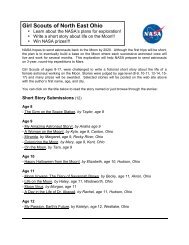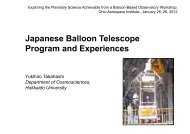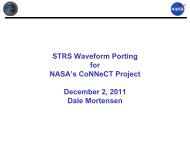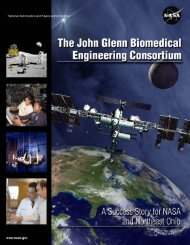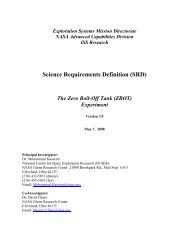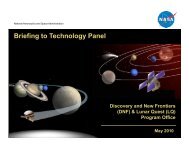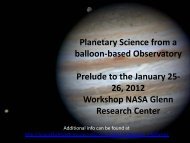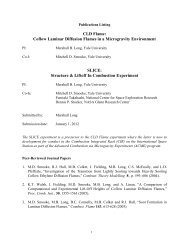Amusement Park Physics With a NASA Twist - Space Flight Systems ...
Amusement Park Physics With a NASA Twist - Space Flight Systems ...
Amusement Park Physics With a NASA Twist - Space Flight Systems ...
You also want an ePaper? Increase the reach of your titles
YUMPU automatically turns print PDFs into web optimized ePapers that Google loves.
<strong>NASA</strong> Connection—Student Reading Guide Answer Key<br />
Free-Fall Rides<br />
1. When do the effects of gravity seem to disappear on free-fall rides<br />
The effects of gravity seem to disappear during the actual fall, when the car and rider are falling at the same rate.<br />
2. How is an orbiting shuttle similar to a free-fall ride The orbiting shuttle is falling toward Earth.<br />
3. What facilities do scientists who study the effects of microgravity use at Glenn Research Center<br />
Scientists use the 2.2-second and 5.2-second drop towers to study microgravity at the Glenn Research Center.<br />
4. Which drop tower located at the Glenn Research Center has the least amount of air resistance<br />
when the experiment drops<br />
The 5.2-second drop tower has the least amount of air resistance because the air is evacuated from the drop<br />
tower before each drop.<br />
Roller Coasters<br />
1. What does it feel like when you are experiencing high g on a roller coaster ride<br />
You get pushed back or pushed down in your seat, you feel like something heavy is on your chest, and at times<br />
your face feels like something is pushing in on it.<br />
2. How long does it take the space shuttle orbiter to travel from the ground to orbit<br />
It takes the Shuttle orbiter 8 minutes to travel from the ground to orbit altitude.<br />
3. What is the KC–135<br />
The KC–135 is a <strong>NASA</strong> research aircraft.<br />
4. How is the KC–135’s flight path similar to a roller coaster<br />
The KC–135 flies parabolas similar to continuous roller coaster hills.<br />
Bumper Cars<br />
1. You collide head-on with another car. Describe how Newton’s third law of motion applies.<br />
Both cars bounce backward because equal and opposite forces are acting on the cars.<br />
2. How does Newton’s second law of motion apply to a rocket launch<br />
The amount of fuel and engine size needed for thrust depends on the weight of the rocket and its payload. The<br />
greater the mass, the greater the amount of force needed to accelerate it.<br />
3. How much microgravity experiment time does a sounding rocket provide<br />
Sounding rockets provide 6 to 8 minutes of microgravity.<br />
Carousel<br />
1. What would happen to the riders if the carousel spun out of control<br />
Riders would fly off of the carousel.<br />
2. What type of acceleration is acting on the riders once the ride has achieved a constant speed<br />
Centripetal acceleration occurs in a turn.<br />
3. The banking of curves on a road is similar to what on a carousel<br />
Banking of road curves is similar to leaning poles and benches on the carousel.<br />
4. How did the first fundamental space biology experiment on the ISS simulate 1 g<br />
The experiment used a centrifuge to spin quail eggs to simulate 1 g in their development.<br />
62<br />
<strong>Amusement</strong> <strong>Park</strong> <strong>Physics</strong> <strong>With</strong> a <strong>NASA</strong> <strong>Twist</strong><br />
EG–2003–03–010–GRC



